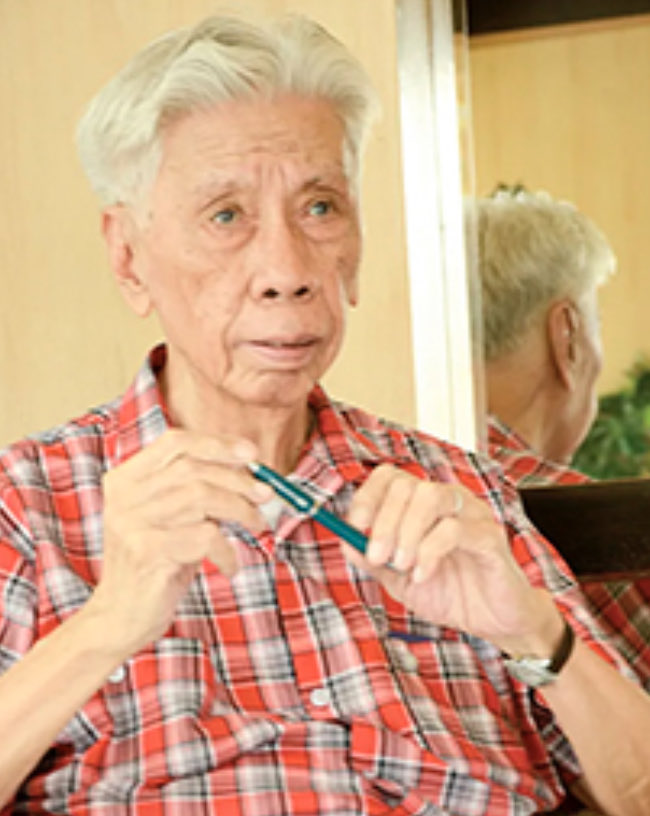Juan Mercado in 2014 farewell columns gave his meaning of ‘writing30’: an older writer telling young journalists,‘ your turn.’
Passage

Juan Mercado in 2014 farewell columns gave his meaning of ‘writing 30’: an older writer telling young journalists, ‘your turn.’
JUAN L. MERCADO
July 2023
[ First article published in SunStar, Dec. 27, 2014; second article in Philippine Daily Inquirer, Dec. 30, 2014 ]
Juan L. Mercado wrote his last column for SunStar on Dec. 27, 2014 and for the Philippine Daily Inquirer on Dec. 30 of the same year. Both columns had the same heading “Writing 30” but had different content. One was for SunStar readers; the other was for a national audience.
A common theme though was the end of his writing stints in both papers — and about the idiom “writing 30.” He was saying good-by and explaining why journalists use “30” and not “29” or any other number.
To journalists, originally it was shorthand for “end” or “no more” to a story or article, on the last page in a dispatch in case the pages were mixed up in the handling. Aside from indicating end of transmission, it was substitute for “best regards” and “good-by.”
These days, it’s still used in the heading of a story about a journalist’s passing away, like “News editor writes 30.” To a journalist who is to retire, “writing 30” is saying good-by, which was the meaning intended by the heading in JLM’s two farewell columns.
Even with the other meanings assigned by journalism to “writing 30,” the number “30” in Webster’s New Collegiate Dictionary is a “sign of completion.” A journalist’s work is done; it is complete. — Pachico A. Seares
1. In SunStar, after 832 columns since 1997, ‘thank you and so long.’ And, yes, ‘30’
[First published in SunStar Cebu, Dec. 27, 2014]

JLM was Asian Media Information & Communication Center’s 2014 awardee. Here, Mercado accepts the AMIC plaque from the Center’s secretary general Ramon Tuazon.
IT has been roughly 832 every-Sunday-columns later, since we started writing for the Sun.Star in mid 1997.
I had just then retired from the United Nations and gave up permanent residence in the US. “You’re a fool,” a fellow journalist snorted. Nonetheless, the wife and I chose to return to Cebu. Shortly, thereafter, Sun.Star asked me to do a column.
“Why did reporters, for years, end their stories by writing: ‘-30-’?” asks journalism professor Louise Reynolds. “Journalism is full of funny phrases and traditions, writing ‘-30-’ is one of them.”
The use of the symbol was once so prevalent that it made its way into Webster’s New Collegiate Dictionary. Writing “-30-” means “a sign of completion.”
So where did the term originate?
“I don’t know,” wrote Philadelphia Bulletin’s Peter Binzen. He ended his 56-year newspaper career with a farewell column that concluded with–what else: “-30-”.
Some say the mark began during a time when stories were submitted via telegraph, with “-30-” denoting “the end” in Morse code.
“I’m not sure that it’s any more of a mystery,” says Linda Steiner, who teaches journalism at the University of Maryland. “Journalists always liked to create odd or weird names for things that they do or conventions that they have.”
In her final New York Times column “Stepping Aside,” Anna Quindlen wrote: Youngsters today account for about a quarter of the population. And so, inevitably, they have created a kind of bottleneck in the work world, including newsrooms. “You guys just won’t go,” said my thoughtful son.
Previously, there was an orderliness to how one generation moved aside and another stepped up to primacy. Life expectancy has stretched. “Even when I was the same age as my children are now, there was a natural transition from one generation to another.”
Every year, a small group of reporters would leave the newsroom, to be replaced by younger ones. “With the harsh insensitivity of youth, I thought this was perfectly fine.”
This makes for a simple equation: fewer opportunities for the young to move in or move up. But many of us of a certain age have had a great deal of difficulty with the concept of getting older. And that means staying front and center professionally. The unspoken synonym for “emeritus” is “old.” And old is modern obscenity.
Changes in news technology have seen the young invent room for themselves… There is nothing quite as tedious, or as useless, as ritual recitations of the good old days, which most often weren’t.
Throughout the world there seems to be an understanding that this is and ought to be a time of reinvention, in the economy, in education, in the office.
But no one seems eager to reinvent on an individual level. Yet never has there been a time when fresh perspective and new ideas were more necessary.
“The torch had been passed to a new generation,” John F Kennedy once said. But torches don’t really get passed very much because people love to hold on to them.
But between the lines I read another message, delivered without rancor or contempt, the same one I once heard from my own son: It’s our turn. Step aside. And now I will.
We too will be stepping aside from over half a century of journalism. And we thank our editors, especially Pachico Seares and Bong Wenceslao, for inviting us, flaws and all, to write for Sun.Star.
We hope to read the younger ones’ take on the world. And so, how do we title this thank-you-and so- long column?
How else but by writing “–30-.” 
2. To Inquirer readers, ‘30’ is passing the torch, stepping aside
[First published in Philippine Daily Inquirer, Dec. 30, 2014]

“You’re a fool,” our fellow journalist snapped at us. “Don’t you realize that there are thousands scrambling to migrate to the United States — or anywhere else?”
Upon retiring from the United Nations, which posted us in Thailand and Italy for 19 years, the wife and I chose to return to the Philippines. Then we gave up our permanent-residence status in the United States, which had earlier given us sanctuary, as it did to previous generations of refugees.
We broke loose from martial-law detention and two years of city arrest under the Marcos dictatorship. For that, we stacked up IOUs that can never be paid.
“Just write anything [in your petition to the President to scram],” counseled then Press Secretary Jacobo Clave, a former colleague in the Evening News. So we scribbled, pledging to obey the laws of the republic. Clave got the signature that was the only law then. Human rights lawyer Joker Arroyo monitored every step of our way to get out and kept the International Press Institute informed.
On the receiving end in UN Thailand, Dioscoro Umali, then regional representative of the Food and Agriculture Organization and subsequent Philippine National Scientist, gave us a temporary job.
“This contract is for three months,” the FAO’s Corazon Uy said. We stayed 17 years, as regular FAO officer. But that’s another story.
Exit from the unlamented “New Society” opened alternate doors for our five children. They chose to become US citizens in the interim. The wife and I chose ìthe road less traveledî — and, as it turned out, a return to journalism.
Shortly thereafter, then Inquirer publisher Isagani Yambot and then Opinion editor Jorge Aruta asked now Presidential Assistant Manuel Quezon III and us to each do a twice-a-week column.
It has been over nine years now since we started crafting Viewpoint columns for the Inquirer. The first column, titled “Trade in orphan tears,” appeared on Feb. 5, 2004.
There is a time for every affair under the sun, Ecclesiastes tells us. And now, it is time to write “-30-,” as reporters over 50 used to do.
So why did journalists then end their stories that way? Journalism is full of funny phrases and traditions, and writing “-30-” is one of them.
The use of the symbol was once so prevalent that it made its way into Webster’s New Collegiate Dictionary. It means “a sign of completion.”
“I don’t know the origin,” wrote the Philadelphia Bulletin’s Peter Binzen. He ended his 56-year newspaper career with a farewell column that concluded with — what else? — ”-30-.”
Some say the mark began during a time when stories were submitted via telegraph, with “-30-” denoting “the end” in Morse code.
“I’m not sure that it’s any more of a mystery than a lot of other things,” observed Linda Steiner, who teaches journalism at the University of Maryland. “Journalists have always liked to create odd or weird names for things that they do or conventions that they have.”
In her final New York Times column, “Stepping Aside,” Anna Quindlen points out: “Youngsters today account for about a quarter of the population. And so, inevitably, they have created a kind of bottleneck in the work world, including newsrooms. ‘You guys just won’t go,’ said my well-mannered and thoughtful son.”
Previously, there was an orderliness to how one generation moved aside and another stepped up to primacy. Life expectancy has stretched. “Even when I was the same age as my children are now, there was a natural transition from one generation to another.”
Every year, a small group of reporters would leave the newsroom, to be replaced by younger ones. “With the harsh insensitivity of youth, I thought this was perfectly fine. But this makes for a simple equation: fewer opportunities for the young to move in or move up.”
“But many of us of a certain age have had a great deal of difficulty with the concept of getting older. And that means staying front and center professionally. The unspoken synonym for ’emeritus’ is’ ‘old.’ And ‘old’ is a modern obscenity.”
Changes in news technology have seen the young invent room for themselves. There is nothing quite as tedious, or as useless, as ritual recitations of the good old days, which most often weren’t.
Throughout the world there seems to be an understanding that this is and ought to be a time of reinvention, in the economy, in education, in the office — and in the newsrooms.
But no one seems eager to reinvent on an individual level. Yet never has there been a time when fresh perspective and new ideas were more necessary.
“The torch has been passed to a new generation,” John F. Kennedy once said. But torches don’t really get passed very much because people love to hold on to them.
But between the lines I read another message, delivered without rancor or contempt, the same one I once heard from my own son: It’s our turn. Step aside. And now I will.
We are doing likewise.
And on stepping aside, may we thank the Inquirer, especially Opinion editor Chato Garcellano, Christine Ang, and staff for bearing with a more than onerous dose of our flaws.
We’ll take pleasure in reading the young ones take on a world where print and the Internet merge in unforeseen combinations.
So, how do we title this thank-you-and so-long column? How else but by “Writing ‘-30-‘”? 

Juan L. Mercado is a columnist for Philippine Daily Inquirer and Cebu Daily News. He writes a Sunday column for Sun-Star Cebu and its syndicated members, Bohol Chronicle and other community papers. He started his career in journalism in early 1950s and served as correspondent for foreign publications including London’s Financial Times and Honolulu-Star Bulletin. Mercado became the Philippine Press Institute’s founding-director. He also edited DEPTHNews, published by the Magsaysay Award-winning Press Foundation of Asia. Following the “People Power Uprising,” and after 19 years of United Nations service, Mercado returned to the Philippines to resume journalism work. He was cited for excellence in opinion writing by Society of Publishers in Asia. In 2005 and 2007, he received the “best columnist award” from the Catholic Archdiocesan Commission for Mass Media. — From Philippine Daily Mirror
